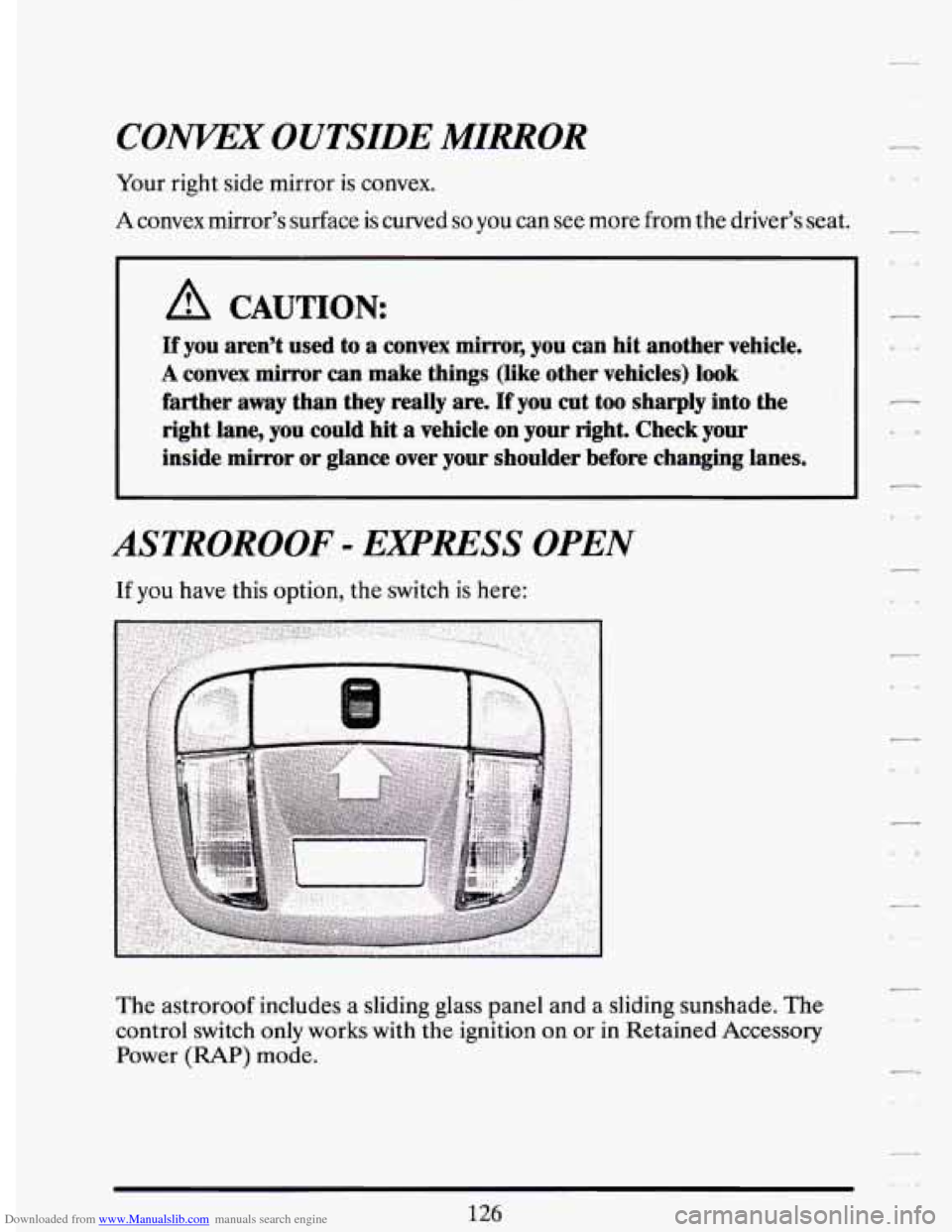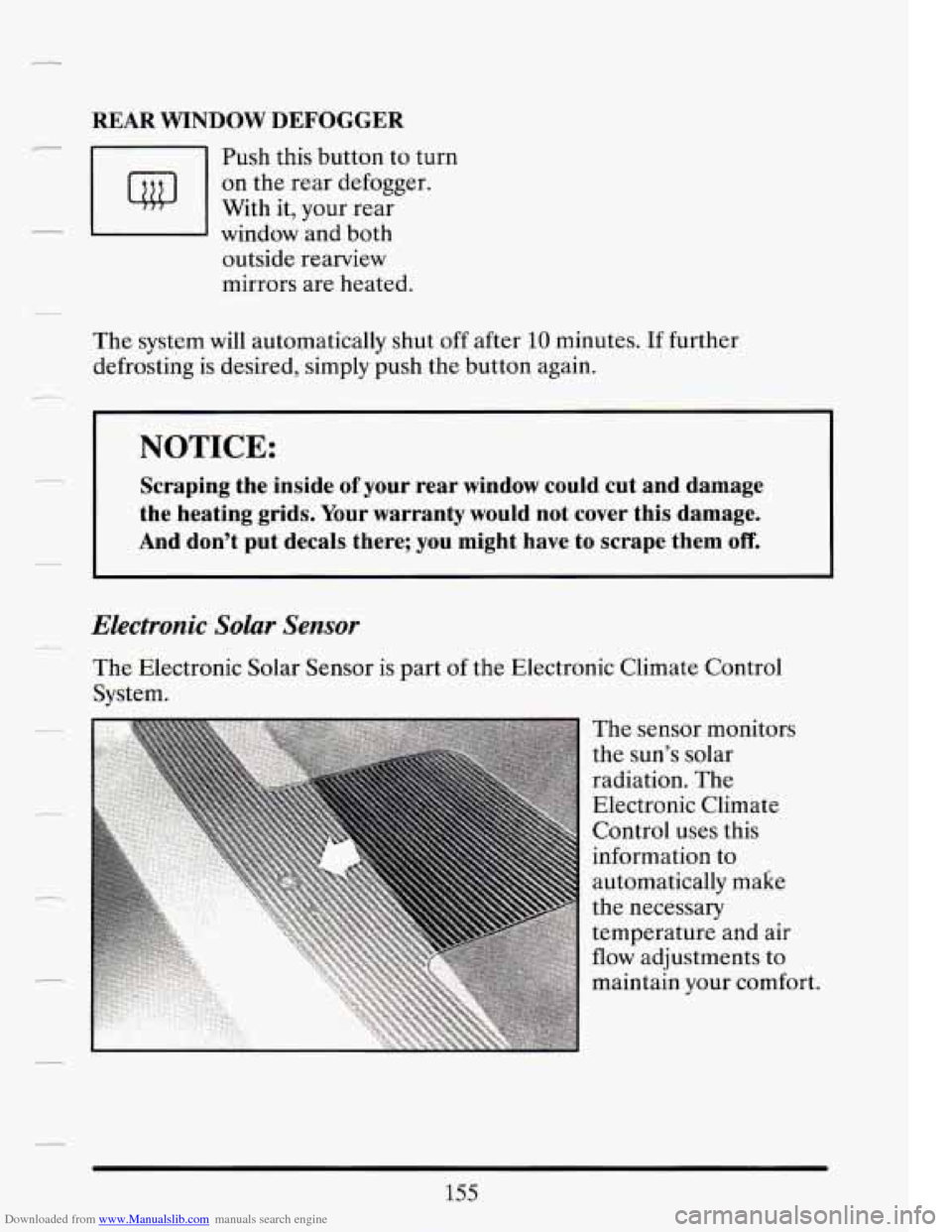mirror CADILLAC DEVILLE 1994 7.G Owners Manual
[x] Cancel search | Manufacturer: CADILLAC, Model Year: 1994, Model line: DEVILLE, Model: CADILLAC DEVILLE 1994 7.GPages: 399, PDF Size: 20.97 MB
Page 133 of 399

Downloaded from www.Manualslib.com manuals search engine Rear Taillamp Monitor
The rear taillamp monitor is located at the top center over the back glass.
You
will see it as you are looking through your inside rearview mirror.
Two red indicators will illuminate to show that your taillights and brake
lights are working.
Page 134 of 399

Downloaded from www.Manualslib.com manuals search engine MIRRORS
Automatic Inside And Outside Rearview Mirrors
Your Cadillac has an
inside automatic
electrochromic rearview mirror
This mirror automatically changes to reduce glare from headlights behind
you.
A photocell on the back of the mirror senses when it is becoming
dark outside. Another photocell built into the mirror surface senses the
headlights behind you.
The mirror will darken gradually to reduce glare. This change may take a
few seconds.
OnlOff Switch
121
Page 135 of 399

Downloaded from www.Manualslib.com manuals search engine Reverse Gear Day Mode
The reverse mode is another important feature of the automatic mirror.
When the shift lever is placed in
“R” ‘(Reverse), the mirror changes to the
daytime mode for a bright image in the mirror as you back up.
Cleaning Photocells
Use a cotton swab and glass cleaner to clean the front and rear photocells
that make the mirror work.
Optional Driver Outside Electrochromic Rearview
Mirror
This mirror automatically dims to minimize glare for maximum rear
visibility.
It operates in conjunction with the inside rearview mirror. As
glare increases the mirror darkens accordingly. When the glare subsides
the mirror returns to its clear daytime state.
122
7
L .-L
Page 137 of 399

Downloaded from www.Manualslib.com manuals search engine Front Seat Vanity Mirrors
To use one, turn the
sunshade down. Then
lift the cover up to see
the mirror.
Illuminated Front Seat Vanity Mirrors
To use the optional
lighted vanity mirrors,
turn the sunshade
down. Then lift the
cover up to see the
mirror. Move the
switch up or down to
either brighten or
dim
the light.
124
a
e
Page 138 of 399

Downloaded from www.Manualslib.com manuals search engine r
r
1
r"
t
The control on the driver's door armrest operates both outside rearview
mirrors. Move the center switch to the left to select the driver side mirror,
or to the right to select the passenger side mirror. Then press the control
pad to adjust each mirror
so that you can just see the side of your vehicle.
To lock the controls leave the selector switch in the middle position.
When
you operate the rear window defogger, it also warms both outside
mirrors to help clear them of fog or ice.
125
Page 139 of 399

Downloaded from www.Manualslib.com manuals search engine COlVVEX OUTSIDE MIRROR
Your right side mirror is convex.
A convex mirror’s surface is curved so you can see more from the driver’s seat.
1 A CAUTION:
ff you aren’t used to a convex mirror, you can hit another vehicle.
A convex mirror c811 make things (like other vehicles) Iook
farther away than they realIy are. If you cut too sharply into the
right lane,
you could hit a vehicle on your right. Check your
inside mirror or glance over your shoulder before changing lanes.
I
ASTROROOF - EXPKESS OPEN
If you have this option, the switch is here:
The astroroof includes a sliding glass panel and a sliding sunshade. The
control switch
only works with the ignition on or in Retained Accessory
Power
(RAP) mode.
126
Page 168 of 399

Downloaded from www.Manualslib.com manuals search engine REAR WINDOW DEFOGGER
Push this button to turn
on the rear defogger.
With it, your rear
window and both
outside rearview
mirrors are heated.
The system will automatically shut
off after 10 minutes. If further
defrosting is desired, simply push the button again.
NOTICE:
Scraping the inside of your rear window could cut and damage
the heating grids. Your warranty would not cover this damage.
And don’t put decals there; you might have to scrape them
off.
Electronic Solar Sert$opi
The Electronic Solar Sensor is part of the Electronic Climate Control
System.
The sensor monitors
the sun’s solar
radiation. The
Electronic Climate
Control
uses this
information to
automatically make
the necessary
temperature and air
flow adjustments to
maintain your comfort.
155
Page 202 of 399

Downloaded from www.Manualslib.com manuals search engine - Do not get too close to the vehicle you want to pass while you’re
awaiting an opportunity. For one thing, following too closely reduces
your area
of vision, especially if you’re following a larger vehicle. Also,
you won’t have adequate space if the vehicle ahead suddenly slows or
stops. Keep back a reasonable distance.
0 When it looks like a chance to pass is coming up, start to accelerate
but stay in the right lane and don’t get too close. Time your move
so
you will be increasing speed as the time comes to move into the other
lane. If the way is clear to pass, you will have a “running start” that
more than makes up for the distance you would lose by dropping back.
And if something happens to cause you to cancel your pass, you need
only slow down and drop back again and wait for another opportunity.
- -- If other cars are lined up to pass a slow vehicle, wait your turn. But
take care that someone isn’t trying to pass you as you pull out to pass
the slow vehicle. Remember to glance over your shoulder and check
the blind spot.
0 Check your mirrors, glance over your shoulder, and start your left lane
change signal before moving out of the right lane to pass. When you
are far enough ahead of the passed vehicle to
see its front in your
inside mirror, activate your right lane change signal and move back
into the right lane. (Remember that your right outside mirror is
convex. The vehicle you just passed may seem to
be farther away from
you than it really is.)
0 Try not to pass more than one vehicle at a time on two-lane roads.
Reconsider before passing the next vehicle.
Don’t overtake a slowly moving vehicle too rapidly. Even though the
brake lights are not flashing, it may be slowing down or starting to
turn.
189
If you’re being passed, make.it easy for the following driver to get
ahead
of you. Perhaps you can ease a little to the right.
Page 204 of 399

Downloaded from www.Manualslib.com manuals search engine While driving on a surface with reduced traction, try your best to avoid
sudden steering, acceleration, or braking (including engine braking by
shifting
to a lower gear). Any sudden changes could cause the tires to
slide. You may not realize the surface is slippery until
your vehicle is
skidding. Learn to recognize warning clues -- such as enough water, ice or
packed snow on the road to make a “mirrored surface”
-- and slow down
when you have any doubt.
Remember:
Any anti-lock braking system (ABS) helps avoid only the
braking skid.
DRn/lNG ATNIGHT
ia
Night driving is more dangerous than day driving. One reason is that
some drivers are
likely to be impaired -- by alcohol or drugs, with night
vision problems, or by fatigue.
Here are some tips on night driving.
Drive defensively.
0 Don’t drink and drive.
Adjust your inside rearview mirror to reduce the glare from headlights
Since you can’t see as well, you may need to slow down and keep more
behind
you.
space
between you and other vehicles.
191
Page 210 of 399

Downloaded from www.Manualslib.com manuals search engine FREEWAYDRIVTNG
Mile for mile, freeways (also called thruways, parkways, expressways,
turnpikes, or superhighways) are the safest
of all roads. But they have
their own special rules.
The most important advice
on freeway driving is: Keep up with traffic and
keep to the right. Drive at the same speed most of the other drivers are
driving. Too-fast
or too-slow driving breaks a smooth traffic flow. Treat
the left lane on a freeway as a passing lane.
At the entrance there is usually a ramp that leads to the freeway.
If you
have a clear
view of the freeway as you drive along the entrance ramp,
you should begin to check traffic.
Try to determine where you expect to
blend with the flow.
Try to merge into the gap at close to the prevailing
speed. Switch
on your turn signal, check your mirrors and glance over
your shoulder as often as necessary.
Try to blend smoothly with the traffic
flow.
Once you are on the freeway, adjust your speed to the posted limit or to
the prevailing rate if it’s slower. Stay in the right lane unless you want to
pass.
Before changing lanes, check your mirrors.
Then use your turn signal.
Just before you leave the lane, glance quickly over your shoulder to make
sure there isn’t another vehicle in your “blind” spot.
197